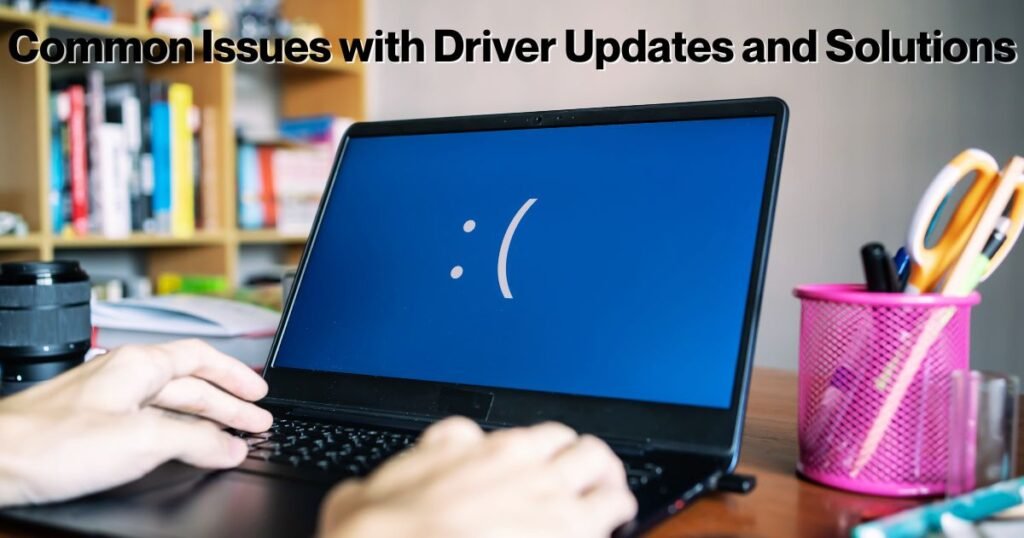How Online Driver Update Enhances Your PC’s Performance?

Online driver updates play a crucial role in keeping your PC running smoothly. By ensuring your drivers are up to date, you not only optimize your computer’s speed but also enhance its security and compatibility with new software and hardware.
Drivers are essential pieces of software that instruct your computer on how to communicate with peripherals, such as printers and graphics cards. When drivers get outdated, they can slow down your system or even cause it to crash.
In this article, we’ll explore the benefits of using online services to update drivers and how they contribute to a better-performing PC.
Understanding Driver Updaters
A driver updater is a tool designed to help you keep your PC’s drivers up to date with minimal effort. It scans your system, identifies outdated or missing drivers, and allows you to download and install the latest versions.
This automation saves users both time and effort, reducing the risk of errors that occur when updating drivers manually.
Automation Benefits:
- Automatically detects outdated drivers
- Saves time by updating drivers without manual search
- Reduces human error, ensuring correct installation
These tools are especially useful for users who may not be tech-savvy or want a hassle-free way to maintain their systems.
By automating the process, you can avoid common pitfalls associated with manual updates, like incorrectly identifying drivers or downloading from unreliable sources.
With the right driver updater, you can ensure your PC stays in top shape, adapting to new software requirements and avoiding performance hiccups. To learn more, check out this comprehensive guide on driver updates and why you need them.
How to Find PC Drivers

Locating and identifying drivers on your PC is a challenge, but it’s a necessary step for maintaining optimal system performance. Here’s how you can tackle it:
Manual Process
- Access Device Manager: Right-click on the “Start” button and select “Device Manager”.
- Identify Devices: In the Device Manager window, you’ll see a list of all the hardware installed on your computer.
- Locate Drivers: Expand each category (e.g., “Display adapters,” “Sound, video, and game controllers”) to find individual drivers.
- Check for Updates: Right-click on a device and select “Update driver” to check for updated versions.
Challenges
- Difficulty in Identification: It’s not always apparent which drivers are outdated.
- Finding Sources: Locating drivers from manufacturers can be time-consuming and sometimes risky, especially when downloaded from unreliable sites.
Guidance
- Consider using dedicated tools to help streamline this process. Tools like Get My Drivers can automatically identify and update your drivers.
- For more detailed guidance, you can visit resources like LifeWire.
Advantages of Driver Update Online Services
Updating your drivers can often be cumbersome if done manually. That’s where online driver update services come into play. These platforms offer several advantages that make keeping your drivers current much easier:
Convenience
- User-Friendly: These services are generally straightforward, requiring minimal technical knowledge.
- Time-Saving: Automated processes save you hours compared to manual updating methods.
Features
Automatic Updates and Extensive Databases: Many services offer hands-free updates, constantly ensuring you have the latest versions installed, and provide access to vast libraries of drivers for almost all hardware manufacturers.
Evidence
Studies indicate that PCs with regularly updated drivers experience fewer issues and better performance. You can check out Intel’s guide on improving in-game FPS.
By taking advantage of these online services, you can ensure that your computer runs smoothly and efficiently, with minimal input on your part.
Read More: New Digital Technology in Thailand
Optimizing PC Drivers for Better Performance

Keeping drivers up to date is akin to a regular tune-up for your PC, ensuring it performs at its best. Regular updates of your drivers can lead to the following:
- Improved Speed: Updated drivers can optimize hardware functionality, translating to quicker load times and more efficient performance.
- Enhanced Stability: Reducing crashes and freezing by fostering harmony between hardware and software components.
- Better Compatibility: Ensuring the latest drivers support new applications and games while maintaining smooth operation for existing ones.
Steps to Set Up Automated Driver Updates
- Choose a Trusted Tool: Use reputable tools like Driver Booster or AVG Driver Updater.
- Install the Software: Follow the installation instructions provided by your chosen tool.
- Scan for Outdated Drivers: Utilize the tool’s scan feature to identify outdated drivers that require updating.
- Review and Update Drivers: Examine the list of outdated drivers and follow the prompts to update them.
- Schedule Regular Updates: Set the tool to automate future checks and updates according to your preferences.
Common Issues with Driver Updates and Solutions

While updating drivers can be beneficial, users may encounter some challenges along the way. Here are common issues and how to tackle them:
- Compatibility Problems:
- Issue: New drivers may sometimes cause software conflicts.
- Solution: Use system restore points or reputable forums, such as Tom’s Hardware, to seek guidance on rolling back to previous versions if necessary.
- Failed Updates:
- Issue: Some updates might not install successfully.
- Solution: Restart your PC and try reinstalling the update. If the issue continues, consult the tool’s customer support or visit online help sections.
- Detection Errors:
- Issue: The tool may not identify some outdated drivers.
- Solution: Cross-reference with manual checks using the Device Manager or contact the tool’s support team for assistance.
By addressing these common issues, you can ensure that your updates proceed smoothly, resulting in more efficient and reliable PC performance.
Final Thoughts and Next Steps
Maintaining your PC’s performance by regularly updating drivers is crucial for optimal operation. Here’s a recap of the main points to help you adopt a routine that enhances your system’s functionality:
Understand the Importance and Utilize Tools: Regular updates can significantly boost speed, security, and compatibility, preventing potential hardware malfunctions. Consider using recognized driver updater tools and online services for automatic updates, which can reduce the hassle of manual checks.
Actionable Steps:
- Regular Practice: Schedule periodic checks using a reliable driver updater to ensure all your drivers are up to date.
- Leverage Online Platforms: Utilize driver update online services for a more convenient and efficient update process.
By committing to these practices, you can enjoy a smoother computing experience with fewer technical hiccups. Remember, keeping your PC in top shape is not just a one-time task but a continuous effort that reflects ongoing care for your technology needs.
FAQs
What is a driver, and why is it important?
A driver is a piece of software that allows your operating system to communicate with your hardware devices, such as printers, graphics cards, and keyboards. Keeping drivers updated ensures that your hardware functions properly and efficiently.
How does updating drivers improve PC performance?
Updating drivers can:
- Fix bugs and glitches in older versions.
- Improve hardware compatibility with new software.
- Enhance system stability and reduce crashes.
- Boost performance for tasks like gaming, video editing, or multitasking.
Can outdated drivers slow down my PC?
Yes, outdated drivers can cause hardware to underperform, lead to system errors, and even result in crashes or freezes, which can significantly slow down your PC.
What are the benefits of using an online driver update tool?
Online driver update tools:
- Automatically detect outdated or missing drivers.
- Save time by eliminating the need for manual searches.
- Ensure you download the correct and latest drivers.
- Provide a user-friendly interface for easy updates.
Is it safe to update drivers online?
Yes, as long as you use a trusted and reputable driver update tool or download drivers directly from the official manufacturer’s website.
How often should I update my drivers?
It’s recommended to check for driver updates every few months or whenever you experience performance issues, hardware malfunctions, or after installing new software.
Can driver updates fix compatibility issues?
Yes, updated drivers often include patches to resolve compatibility issues between hardware and new operating systems or software.
Do driver updates improve gaming performance?
Absolutely! Updated graphics and sound drivers can enhance gaming performance by providing better frame rates, improved visuals, and reduced latency.
What happens if I don’t update my drivers?
If you don’t update your drivers, you may experience:
- Reduced hardware performance.
- Increased system crashes or errors.
- Incompatibility with new software or operating systems.
Are there risks involved in updating drivers?
While rare, risks include downloading incorrect drivers or encountering installation errors. Using a reliable driver update tool minimizes these risks.
Can I update drivers manually instead of using an online tool?
Yes, you can manually update drivers by visiting the hardware manufacturer’s website, finding the correct driver for your device, and installing it. However, this process can be time-consuming and prone to errors.
Do online driver update tools work for all types of hardware?
Most online driver update tools support a wide range of hardware, including graphics cards, sound cards, network adapters, and various peripherals such as printers and scanners.
Are free driver update tools effective?
Some free tools are effective, but they often have limitations, such as fewer features, slower updates, or the inclusion of ads. Premium tools often provide better reliability, support, and additional features.
How do I choose the best online driver update tool?
Look for tools that:
- Have positive reviews and a good reputation.
- Offer automatic scans and updates.
- Provide a backup and restore feature.
- Are compatible with your operating system.
Can driver updates extend the lifespan of my PC?
While driver updates won’t physically extend your PC’s lifespan, they can keep your system running smoothly and efficiently, delaying the need for hardware upgrades.




